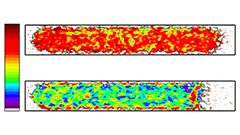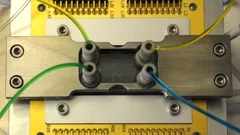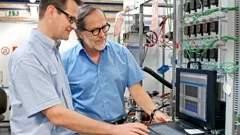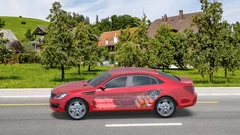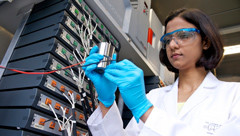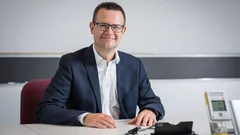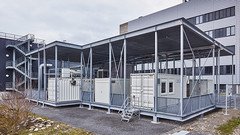Search
Ice in fuel cells imaged directly for the first time
Researchers from the Paul Scherrer Institute (PSI) have succeeded in imaging the distribution of frozen and liquid water in a hydrogen fuel cell directly for the first time. They applied a new imaging technique that uses successively two beams with different neutron energies to distinguish between areas with liquid water and those with ice extremely reliably. The method therefore opens up the prospect of studying one of the main problems of using fuel cells to power vehicles: ice can clog the pores in the fuel cells and affect their performance. The PSI scientists’ results will be published in the journal Physical Review Letters on 16 June 2014.
Zukünftige Computerchips mit "elektronischem Blutkreislauf"
Im Rahmen des Sinergia-Programms fördert der Schweizerische Nationalfonds das dreijährige Forschungsvorhaben REPCOOL. Unter der Leitung von IBM Research à Zürich arbeiten in diesem Projekt Wissenschaftler der ETH Zürich, des Paul Scherrer Instituts in Villigen und der Università della Svizzera italiana in Lugano gemeinsam an der Erforschung eines elektronischen Blutkreislaufs für zukünftige 3D-Computerchips. Vom menschlichen Gehirn inspiriert, entwickeln die Forscher ein Mikrokanalsystem mit einer elektrochemischen Flussbatterie, die 3D-Chipstapel gleichzeitig kühlen und mit Energie versorgen. Ultimatives Ziel ist die Entwicklung eines Supercomputers in PC-Grösse.Cette actualité n'existe qu'en allemand.
La Suisse en route vers le zéro net
Les institutions du Domaine des EPF mettent en commun leur expertise pour atteindre l’objectif zéro net.
Cinq fois moins de platine : grâce à un nouveau catalyseur aérogel, les piles à combustible pourraient devenir économiquement attrayantes
Les piles à combustible produisent de l’électricité à partir d’hydrogène et n’émettent que de l’eau, elles sont une alternative écologique pour la mobilité individuelle du futur. Depuis plus de 10 années, l’Institut Paul Scherrer (PSI) étudie et développe des piles à combustibles basse température à membrane polymère. Les premiers tests pratiques ont montré que ces piles à combustible peuvent être utilisées avec succès pour des voitures et des bus. Mais d’autres recherches restent nécessaires pour améliorer la longévité de cette technologie et la rendre économiquement viable. Une équipe internationale de chercheurs, à laquelle participe le PSI, a fabriqué un nanomatériau potentiellement capable d’améliorer la performance et la durabilité de ces piles à combustible à tout en réduisant les coûts.
Green fuels for aviation
In a new initiative, PSI and Empa want to jointly develop a process for producing kerosene from renewable resources.
Toward better motors with X-ray light
Making Switzerland's road traffic fit for the future calls for research, first and foremost. In the large-scale research facilities of PSI, chemists and engineers are investigating how to improve the efficiency of motors and reduce their emissions.
Energy transition
Topic Overview
Energy and Climate
Topic Overview
How important is hydrogen for the energy transition?
Assessments by PSI energy expert Thomas J. Schmidt
ESI-Plattform
Themenübersicht
